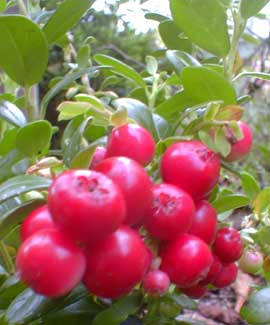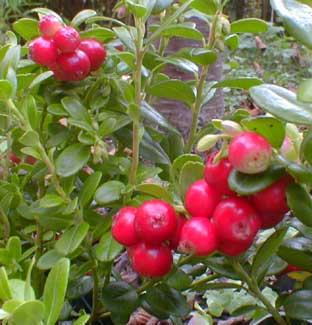
'Balsgard'
Lingonberry
"Went far into the tangled wild,
Her little pail with luscious treasure
Of berries ripe to fill--the child
Knew they would give her mother pleasure."
-Janet Hamilton
(1795-1873)
(1795-1873)
Introduced in the United States in 2004, Vaccinium vitis-idaea var majus 'Balsgard' was developed in the Lingonberry Program of the Swedish University of Agricultural Sciences, in Balsgard in the south of Sweden. The Lingonberry Program was starteed in 1978 from plant material gathered by the Danish horiticultural professor Sven Dahlbro in the province of Smaland in Sweden. This program aimed at plants with high yield, upright habit, large fruit size, good flavor, restricted rhizomes for a more compact mounding rather than spreading shrub, & easy propagation from cuttings.
'Balsgard' is this cultivar's trademark name assigned to it in the United States. The Swedish University gave it the unlovely designation '8723-10.' It is presently the largest lingonberry in the marketplace, & it bears very heavily.
 'Balsgard' was bred specifically for higher fruit production. The shrub grows a little more slowly than less fruitful varieties but is nevertheless vigorous & reliable. The unusually large berries ripen in September, in extravagant numbers, with exceptional taste for jellies, jams, syrups, sauces, or wine. It is virtually immune to diseases.
A very upright & narrowly compact little evergreen shrub, it produces far fewer rhizomes than older cultivars such as 'Red Pearl.'
'Balsgard' was bred specifically for higher fruit production. The shrub grows a little more slowly than less fruitful varieties but is nevertheless vigorous & reliable. The unusually large berries ripen in September, in extravagant numbers, with exceptional taste for jellies, jams, syrups, sauces, or wine. It is virtually immune to diseases.
A very upright & narrowly compact little evergreen shrub, it produces far fewer rhizomes than older cultivars such as 'Red Pearl.'It flowers April/May & reflowers in June/July, producing two fruit crops for July/August & September/October. Though the evergreen foliage is exceedingly hardy & looks fresh & evergreen year-round, the blossoms can be sensitive to frost. This means that a late frost can reduce the number of fruits for the first crop, or winter temperatures that arrive early can keep the larger second crop from fully ripening.
On Puget Sound with plenty of sun & even moisture, there is invariably two good crops. If planted in a shadier location they will still be attractive evergreen shrubs but will fruit far less, & in deeper shade will have rangier growth requiring more trimming, without fruiting.
The fruit of 'Balsgard' by right of its larger size ripens a little later than most of the common cultivars, althougyh this can vary. We found that autumn fruits ripen mid-September before 'Red Pearl' a week or two later; but most reports indicate 'Red Pearl' should ripen first.
Although lingonberries are self-pollinating, they produce more & larger fruits that ripen a bit earlier if there are mulitiple cultivars planted in groups. The presence of mason bees or honeybees also improves yields. The SinLur Gardens lingonberry patch serves both as an ornamental groundcover & heavy fruit production, intermixing 'Balsgard,' 'Red Pearl,' & 'Koralle.' There is also a single Java Mountain Lingonberry (Vaccinium erythrinum) & two wee Gumpo azaleas (one red, one white) with similar leaf-size, to gussy-up the ornamentality of the patch.
Lingonberries require acidic soil that has a great deal of organic matter, moist but well-draining. In ideal conditions some varieties can be aggressive, spreading by rhizomes slowly but inexorably, with a capacity to displace anything its own size or smaller that gets in its path. In this regard 'Balsgard' is less aggressive, giving so much of its energy to its fruit that it remains a tidy tight clump. 'Red Pearl' by comparison can more easily develop into a complete groundcover via rhizomes.